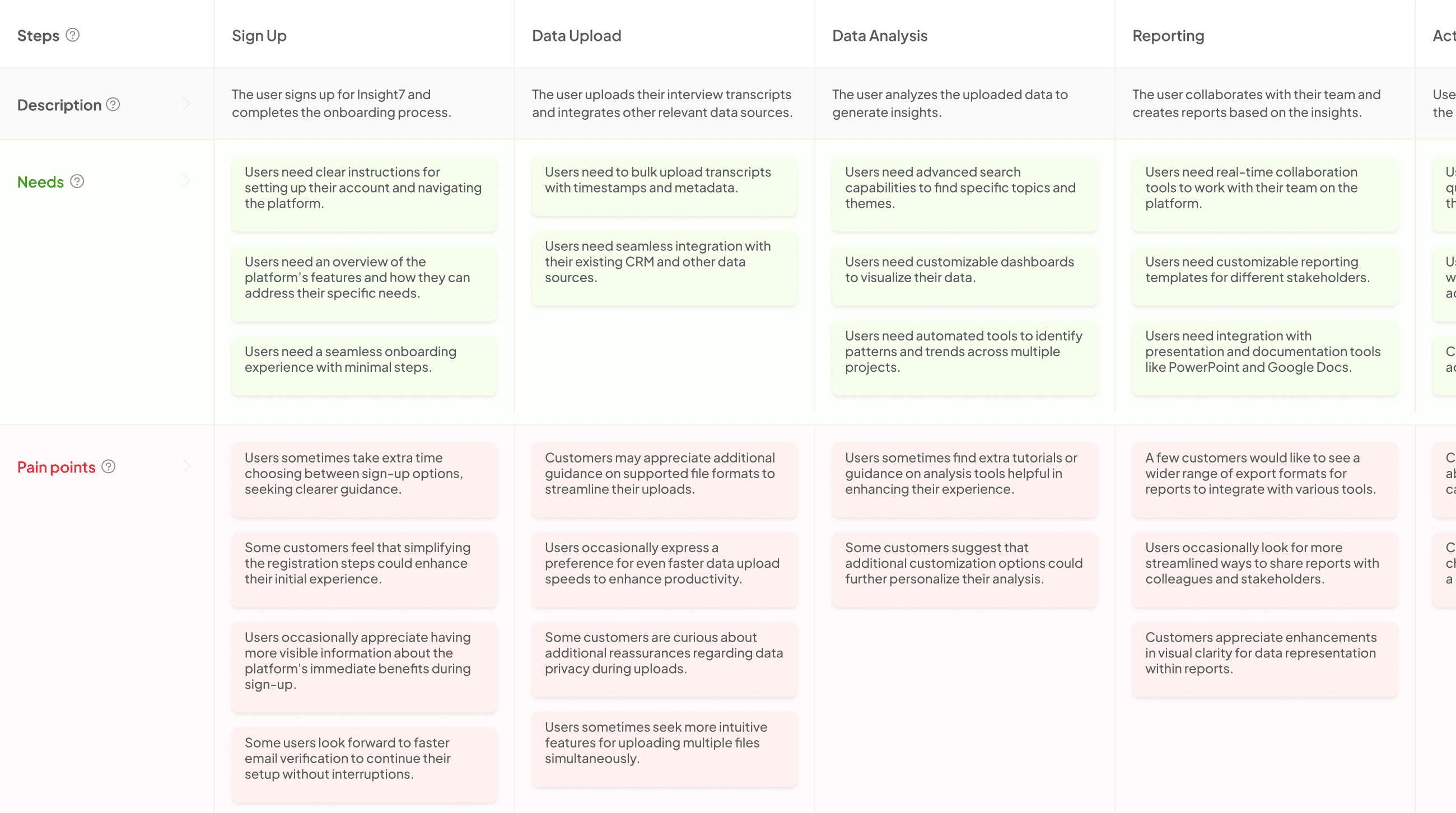Best AI tools for generating journey maps from conversations
-
Bella Williams
- 10 min read
Conversational Journey Mapping is a powerful tool for understanding customer experiences through dialogue. By analyzing conversations, organizations can uncover what customers truly feel and think at every touchpoint of their journey. This method identifies pain points, preferences, and expectations that arise during interactions, enabling teams to create a more user-friendly experience.
Incorporating AI tools enhances this mapping process by transforming raw dialogue data into actionable insights. These insights can guide improvements, making the journey smoother for customers. Ultimately, mastering Conversational Journey Mapping opens the door to deeper engagement and loyalty, aligning service offerings more closely with customer needs.
Extract insights from Customer & Employee Interviews. At Scale.

Understanding Conversational Journey Mapping
Conversational Journey Mapping starts by understanding the various stages a customer goes through during their interaction with a service or product. This mapping process captures both the emotional and functional aspects of customer conversations, turning them into visual representations that highlight touchpoints and pain points. By analyzing these conversations, businesses can pinpoint areas of friction and opportunities for improvement.
The resulting journey maps provide a comprehensive view of customer experiences, from initial research to final decision-making. They help organizations not only visualize customer needs but also formulate actionable strategies to enhance the experience. Ultimately, implementing Conversational Journey Mapping allows businesses to foster better engagement, increase customer satisfaction, and streamline their services by addressing the most pressing issues identified during these interactions.
What is Conversational Journey Mapping?
Conversational Journey Mapping is an innovative approach to visualizing customer interactions and experiences throughout their journey with a brand. It focuses on understanding the customer's emotions, pain points, and needs as they engage in conversations—be it through calls, chats, or other communication channels. By analyzing transcripts and extracting relevant data, businesses can identify significant moments that impact customer satisfaction.
This method emphasizes the importance of each touchpoint, offering insights into how customers perceive the service. By mapping these experiences, companies can address friction points, enhance communication strategies, and ultimately improve customer relations. A well-executed Conversational Journey Map enables organizations to visualize and prioritize changes that lead to a more streamlined customer experience, ensuring that every conversation contributes to customer retention and satisfaction.
Benefits of Using Conversational Journey Mapping
Conversational Journey Mapping offers a structured approach to understanding customer interactions. By analyzing conversational data, businesses can uncover key friction points in the customer experience. This method enables organizations to visualize the journey from initial awareness to post-purchase feedback, making it easier to identify where enhancements are needed.
Furthermore, utilizing Conversational Journey Mapping allows for more impactful decision-making. It transforms abstract customer feedback into actionable insights, helping teams prioritize improvements effectively. For example, identifying repetitive issues within conversations can guide product development or service adjustments, ultimately elevating the overall customer experience. This systematic approach streamlines strategic planning, ensuring that all team members are aligned on customer needs and expectations. Adopting Conversational Journey Mapping is not just about visualizing data; it’s about fostering a deeper connection with customers through informed insights.
Generate Journey maps, Mind maps, Bar charts and more from your data in Minutes
Best Conversational Journey Mapping Tools
Conversational Journey Mapping is an essential process for understanding customer experiences throughout their interactions with a brand. Utilizing AI tools to create journey maps from conversations enhances the clarity of these experiences by visualizing critical touchpoints. In this context, tools such as SentiOne, Talla, Chorus.ai, and Conversocial stand out for their ability to analyze conversational data effectively.
These tools help identify patterns and pain points that users encounter during their journey. They convert voice transcripts or chat logs into actionable insights, allowing organizations to refine their services. For instance, SentiOne excels in sentiment analysis, providing a nuanced understanding of customer emotions. Talla automates responses, improving customer service efficiency. Meanwhile, Chorus.ai focuses on conversation analytics that reveal underlying trends. Finally, Conversocial fosters social engagement, ensuring companies respond to customer queries promptly. Each tool contributes to creating a more seamless customer experience, ultimately driving satisfaction and loyalty.
Insight7: Leading the Way
In the realm of customer interactions, Conversational Journey Mapping is emerging as a transformative approach. This method focuses on capturing and analyzing customer conversations to create a comprehensive understanding of the customer's experience. By systematically examining the communication between customers and service representatives, organizations can identify key touchpoints that shape customer satisfaction and loyalty.
As we explore the concept of Insight7: Leading the Way, it's essential to recognize how AI-driven tools are reshaping this landscape. These tools automate the analysis of conversations, enabling faster insights and more effective action plans. By harnessing the power of AI, businesses can efficiently turn raw customer data into actionable strategies. This proactive engagement fosters a shift from reactive service to meaningful conversations, ultimately enhancing the overall customer journey. As organizations adopt these innovative solutions, they position themselves to thrive in a competitive environment.
Additional Top Tools
To enhance the process of Conversational Journey Mapping, exploring additional top tools can make a significant difference. Several noteworthy platforms stand out, each offering unique functionalities to streamline data analysis from customer interactions. First on the list is SentiOne, which excels in social listening and provides essential insights into customer feedback across various channels. This tool helps businesses understand sentiment and trends in real time, paving the way for improved engagement strategies.
Next, Talla offers an AI-driven approach to automate communication while gathering valuable insights. It assists customer service teams in refining their responses, ultimately enhancing the customer experience. Chorus.ai captures and analyzes sales calls, providing actionable insights that can inform strategy adjustments and training initiatives. Lastly, Conversocial focuses on customer service interactions, enabling companies to manage conversations efficiently and maintain meaningful relationships with clients. These tools collectively contribute to more effective Conversational Journey Mapping, ensuring that organizations can respond to customer needs in a timely manner.
- SentiOne
Conversational Journey Mapping involves tracking customer interactions to better understand their experiences. One valuable tool in this space focuses on converting raw conversational data into actionable insights. With these insights, organizations can address customer needs more effectively and enhance overall engagement.
This tool excels in processing vast amounts of conversational data from customer interactions, assisting in identifying patterns and trends. By analyzing these conversations, companies can better visualize the customer journey, pinpointing critical touchpoints that matter most to their audience. The focus lies on speeding up the analysis and ensuring that insights can be quickly transformed into strategic actions, greatly improving the responsiveness of customer-facing teams.
Utilizing this technology helps organizations collect feedback and reactions in real-time, fostering a more proactive customer service approach. By focusing on understanding customers, businesses can create responses that directly speak to client needs, ultimately leading to a more satisfying experience.
- Talla
Talla serves as a pivotal tool in the realm of Conversational Journey Mapping. Its design focuses on automating the extraction of insights from conversations, allowing businesses to understand customer experiences better. By leveraging advanced AI technology, Talla processes a substantial volume of conversations, identifying key moments that can enhance user journeys.
The platform excels at pinpointing customer sentiment and interaction patterns, which are crucial for developing effective strategies. As organizations strive to improve customer service, using Talla not only streamlines data analysis but also equips teams with vital information to make informed decisions. By integrating Talla into their workflow, companies can elevate their communication strategies and ultimately enhance customer satisfaction. This innovative tool plays a significant role in transforming raw conversation data into actionable insights for lasting improvement.
- Chorus.ai
The platform excels in simplifying the process of conversational journey mapping. Users can effortlessly input recorded conversations, enabling the tool to generate valuable insights. By providing a user-friendly interface, it empowers businesses to gather and analyze customer interactions efficiently. The capability to transcribe multiple files simultaneously enhances scalability, allowing businesses to monitor customer sentiments on a larger scale.
Additionally, the tool enables users to filter and summarize data, highlighting key pain points and enabling a clear understanding of customer needs. Workflow templates facilitate various tasks, such as customer discovery and understanding the voice of the customer. By seamlessly extracting evidence-backed insights directly from conversations, organizations can optimize engagement strategies. This streamlined approach to conversational journey mapping ultimately strengthens customer relations and informs business decisions with actionable insights.
- Conversocial
Conversational Journey Mapping serves as an essential framework for understanding customer interactions in a digital environment. It encapsulates the customer experience by tracking conversational data and translating it into actionable insights. By focusing on the nuances of customer conversations, organizations can identify critical touchpoints and address user needs more effectively. This method helps businesses connect with customers on a deeper level, creating a more personalized engagement.
Utilizing effective tools for Conversational Journey Mapping allows companies to analyze vast amounts of conversation data. These tools streamline the process, making it easier to gather and interpret insights quickly. As businesses strive to remain competitive, accurately mapping conversational journeys becomes crucial. With solutions tailored to enhance interaction understanding, improving overall customer satisfaction and driving better business outcomes is achievable. By leveraging these insights, organizations can ultimately foster stronger relationships with their customers.
Steps to Implement Conversational Journey Mapping with AI Tools
To implement Conversational Journey Mapping effectively, start by identifying key conversation points from your customer interactions. Gather transcripts and recordings of significant conversations that highlight customer experiences. Focus on capturing moments that reveal pain points, desires, or specific behaviors. This foundational step ensures that you have relevant data to analyze later, painting an accurate picture of your customer's journey.
Next, utilize AI tools to visualize these insights. Many platforms allow for easy integration of your conversations and will automatically extract essential themes and trends. By visualizing this data, you can better understand where bottlenecks or friction points exist in the customer journey. Finally, analyze the visualized data to iterate on your processes. Continuous assessment and refinement based on real-time customer feedback will enhance your overall strategy and improve customer experience dramatically. By following these structured steps, businesses can leverage AI effectively for impactful Conversational Journey Mapping.
Step 1: Identifying Key Conversation Points
Identifying key conversation points is crucial in Conversational Journey Mapping. This step involves analyzing transcripts and conversations to extract meaningful insights. By categorizing information based on themes, you can pinpoint recurring topics or pain points that customers frequently mention. Look for keywords that emerge consistently; these will often illuminate the main areas of concern or interest within customer interactions.
To effectively identify these conversation points, consider the following strategies:
- Aggregate Data: Collect all relevant conversations within a specific timeframe. This allows you to spot trends more easily.
- Thematic Analysis: Organize conversations into categories based on thematic elements. Focus on both pain points and positive feedback.
- Summarize Findings: Create a high-level summary that captures the essence of customer sentiments. Highlight the most frequently mentioned topics to inform decision-making.
By leveraging these techniques, you can enhance your understanding of customer experiences, steering your efforts toward more significant improvements. This foundational step leads directly to more effective journey mapping and positive business outcomes.
Step 2: Using AI Tools to Visualize
Using AI tools for visualization allows for a more dynamic way to represent the data collected from conversations. With Conversational Journey Mapping, visualizing data not only highlights significant insights but also makes patterns and trends easier to identify. This process often incorporates various graphical formats—such as flowcharts, heat maps, or timelines—that can distill complex information into clear and actionable visuals.
To effectively leverage these AI tools, there are a few strategies to consider. First, choose the right tool based on your data needs; some tools specialize in sentiment analysis while others excel in comparative analysis. Next, input diverse conversation datasets to uncover a comprehensive view of customer experiences. Finally, continually refine your visuals based on feedback and additional data, ensuring your journey maps evolve alongside customer interactions. By embracing these practices, organizations can gain a deeper understanding of their journey maps and enhance the overall customer experience.
Step 3: Analyzing and Iterating
In Step 3: Analyzing and Iterating, the focus is on extracting valuable insights from the data gathered during conversations. It's crucial to examine both positive and negative feedback to understand customer sentiment fully. By identifying trends and patterns in this data, businesses can spot opportunities for improvement and innovation. Each iteration should serve as a foundation for deeper analysis, enhancing the overall strategy in the conversational journey mapping process.
Regularly revisiting the data not only helps in fine-tuning existing approaches but also paves the way for new ideas. As you analyze this information, it’s essential to stay flexible and adapt to emerging trends or shifts in customer behavior. Iterative loops of feedback and adjustment will ensure continuous enhancement of the customer journey, aligning product offerings and services with user expectations. Emphasizing this cycle of analysis and iteration ultimately drives success in conversational journey mapping.
Conclusion on Conversational Journey Mapping
Conversational Journey Mapping provides businesses with a powerful framework to analyze customer interactions. By focusing on each touchpoint, organizations can identify pain points and enhance the overall user experience. This mapping process transforms raw conversation data into actionable insights, allowing companies to visualize the customer journey from inquiry to decision-making.
In conclusion, leveraging AI tools for Conversational Journey Mapping can significantly improve how businesses understand and respond to customer needs. It fosters a proactive approach, enabling organizations to anticipate challenges and optimize service strategies effectively. Embracing this method ultimately leads to more meaningful engagements and enhanced satisfaction for customers.







